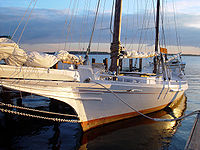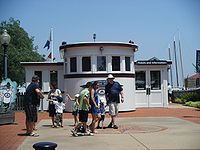
Chesapeake Bay Maritime Museum
Encyclopedia

St. Michaels, Maryland
Saint Michaels is a town in Talbot County, Maryland, United States. The population was 1,193 at the 2000 census. Saint Michaels derives its name from the Episcopal Parish established here in 1677...
, Maryland
Maryland
Maryland is a U.S. state located in the Mid Atlantic region of the United States, bordering Virginia, West Virginia, and the District of Columbia to its south and west; Pennsylvania to its north; and Delaware to its east...
, United States
United States
The United States of America is a federal constitutional republic comprising fifty states and a federal district...
and is home to a collection of Chesapeake Bay
Chesapeake Bay
The Chesapeake Bay is the largest estuary in the United States. It lies off the Atlantic Ocean, surrounded by Maryland and Virginia. The Chesapeake Bay's drainage basin covers in the District of Columbia and parts of six states: New York, Pennsylvania, Delaware, Maryland, Virginia, and West...
artifacts
Artifact (archaeology)
An artifact or artefact is "something made or given shape by man, such as a tool or a work of art, esp an object of archaeological interest"...
, exhibition
Exhibition
An exhibition, in the most general sense, is an organized presentation and display of a selection of items. In practice, exhibitions usually occur within museums, galleries and exhibition halls, and World's Fairs...
s, and vessels
Watercraft
A watercraft is a vessel or craft designed to move across or through water. The name is derived from the term "craft" which was used to describe all types of water going vessels...
. This 18 acres (72,843.5 m²) interactive museum
Museum
A museum is an institution that cares for a collection of artifacts and other objects of scientific, artistic, cultural, or historical importance and makes them available for public viewing through exhibits that may be permanent or temporary. Most large museums are located in major cities...
was founded in 1965 on Navy Point, once a site of seafood packing houses, docks, and work boats. Today, the Museum houses the world's largest collection of Chesapeake Bay boats and provides interactive exhibits in and around the 35 buildings which dot the campus. The Museum also offers year-round educational seminars and workshops.
Exhibits

Geology
Geology is the science comprising the study of solid Earth, the rocks of which it is composed, and the processes by which it evolves. Geology gives insight into the history of the Earth, as it provides the primary evidence for plate tectonics, the evolutionary history of life, and past climates...
, economic, and social
Social history
Social history, often called the new social history, is a branch of History that includes history of ordinary people and their strategies of coping with life. In its "golden age" it was a major growth field in the 1960s and 1970s among scholars, and still is well represented in history departments...
stories of the Bay and those that lived there. Museum visitors can view over 100 boats and boat models, various artworks including a vast collection of watercolors, decoys, guns, ship’s signboards, and other historical Bay artifacts. Larger structures include the original Tilghman Island’s Knapps Narrows drawbridge and the 1879 Hooper Strait
Hooper Strait Light
Hooper Strait Light is one of four surviving Chesapeake Bay screw-pile lighthouses in the U.S. state of Maryland. Originally located in Hooper Strait, between Hooper and Bloodsworth Islands in Dorchester County and at the entrance to Tangier Sound, it is now an exhibit at the Chesapeake Bay...
Chesapeake screw-pile lighthouse
Screw-pile lighthouse
A screw-pile lighthouse is a lighthouse which stands on piles that are screwed into sandy or muddy sea or river bottoms. The first screw-pile lighthouse was built by blind Irish engineer Alexander Mitchell...
. At the Museum’s working boatyard, visitors can have their hand at constructing a wooden skiff through the Apprentice for a Day program (see below). One of the interactive exhibits the Museum offers is Waterman's Wharf, where one can practice seafood harvesting by hauling an eel or crab pot out of the waters of Fog Cove. Another exhibit, Oystering on the Chesapeake, transports visitors to the deck of a working waterman, and explains how the oyster industry has shaped the region’s landscape, culture, and history.

Edna E. Lockwood (bugeye)
The Edna E. Lockwood is a Chesapeake Bay bugeye, the last working oyster boat of her kind. She is located at the Chesapeake Bay Maritime Museum in Saint Michaels, Maryland. She was built in 1889 at Tilghman Island, Maryland by John B...
, a National Historic Landmark
National Historic Landmark
A National Historic Landmark is a building, site, structure, object, or district, that is officially recognized by the United States government for its historical significance...
, and the last sailing log-bottom bugeye
Bugeye
The bugeye is a type of sailboat developed in the Chesapeake Bay for oyster dredging. The predecessor of the skipjack, it was superseded by the latter as oyster harvests dropped.- Origins :...
. The museum helps keep the Chesapeake Bay log canoe racing tradition alive through preserving and sailing the Edmee S.
Edmee S. (log canoe)
The Edmee S. is a Chesapeake Bay log canoe. She was built in the Tilghman Island style from hewn logs by Oliver Duke in the 1930's. She is one of the last 22 Chesapeake Bay racing log canoes, and is actively raced with a crew of nine to eleven people. Her original name was Cecilia Mae, but was...
, the museum’s own log racing canoe
Log canoe
The log canoe is a type of sailboat developed in the Chesapeake Bay region. Based on the dugout, it was the principal traditional fishing boat of the bay until superseded by the bugeye and the skipjack. However, it is most famous as a racing sailboat, and races continue to be held.The history of...
, which is crewed and raced by Museum staff on weekends in the summer. The dredgeboat Old Point, built from seven logs in 1909, was once used to haul fresh fish in the winter, carry oysters during the fall, and dredge clams during the summer. Today, it offers kids a hands on and onboard "waterman" experience. Mister Jim, the museum’s replica buyboat, takes museum visitors out on the water for tours of the Bay throughout summer weekends. Through the variety of exhibits, the Museum provides the opportunity for all to experience the history and culture of the Chesapeake Bay region.
Education and outreach
A community sailing program is offered to teach the basics of sailing. The Lighthouse Overnight Program allows children to experience the life of a mariner standing watch overnight. The Museum also provides programs for children such as Kids Club, as well as hands-on games, crafts, and storytelling throughout the year. For adults, the Museum's programs include a Lecture Series, Adult-Guided Tours, and the Academy for Lifelong Learning, a series of courses centered around continuing learning inside the classroom and beyond. In addition to a variety of programs, the Museum offers a 10,800-volume library of ship plans, manuscripts, books, and sketches.Working boatyard
The Museum has a working boatyard for restoration projects and education. Visitors can learn about the restoration of commercial skipjacks and the preservation of the Museum's own floating fleet. The "Apprentice for a Day" program allows visitors to help construct a wooden skiffSkiff
The term skiff is used for a number of essentially unrelated styles of small boat. The word is related to ship and has a complicated etymology: "skiff" comes from the Middle English skif, which derives from the Old French esquif, which in turn derives from the Old Italian schifo, which is itself of...
under the guidance of boatyard staff members.

